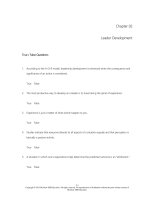Leadership enhancing the lessons of experience 8th by hughes curphy chap 13
Bạn đang xem bản rút gọn của tài liệu. Xem và tải ngay bản đầy đủ của tài liệu tại đây (1.13 MB, 33 trang )
Copyright © 2015 McGraw-Hill Education. All rights reserved. No reproduction or distribution without the prior written consent of McGraw-Hill Education.
13-1
Chapter
13
Contingency Theories of
Leadership
“It is a capital mistake to theorize
before one has data.”
~Sir Arthur Conan Doyle
13-2
Introduction
• Leadership is contingent upon the interplay of
all three aspects of the leader-follower-situation
(L-F-S) model.
• Four other theories share similarities:
1. They are theories rather than personal opinions.
2. They implicitly assume that leaders are able to
accurately diagnose or assess key aspects of the
followers and the leadership situation.
3. With the exception of the contingency model, leaders
are assumed to be able to act in a flexible manner.
4. A correct match between situational and follower
characteristics and leaders’ behavior is assumed to
have a positive effect on group or organizational
outcomes.
13-3
Leader-Member Exchange (LMX)
• LMX argues that leaders do not treat all
followers like a uniform group of equals.
• The leader forms specific and unique
linkages with each subordinate, creating a
series of dyadic relationships.
– With the out-group, or low-quality exchange
relationships, interpersonal interaction is limited
to fulfilling contractual obligations.
– With the in-group, leaders form high-quality
exchange relationships that go beyond what the
job requires and benefit both parties.
13-4
The Cycle of Leadership Making
Table 13.1: The Cycle of Leadership Making: Source
13-5
The Normative Decision Model
• The level of input subordinates have in decisionmaking varies substantially depending on the
issue, the followers’ technical expertise, or the
presence/absence of a crisis.
• Vroom and Yetton maintained that leaders could
often improve group performance by using an
optimal amount of participation in the decisionmaking process.
• The normative decision model is directed
solely at determining how much input
subordinates should have in the decisionmaking process.
13-6
Levels of Participation
• The normative decision model was designed to
improve some aspects of leadership
effectiveness.
• Vroom and Yetton explored how various leader,
follower, and situational factors affect the
degree of subordinates’ participation in the
decision-making process and, in turn, group
performance.
• A continuum of decision-making processes
ranging from completely autocratic (AI) to
completely democratic (GII) was discovered.
13-7
Decision Quality and Acceptance
• Vroom and Yetton believed decision quality and
decision acceptance were the two most
important criteria for judging the adequacy of a
decision.
• Decision quality means that if the decision has
a rational or objectively determinable “better or
worse” alternative, the leader should select the
better alternative.
• Decision acceptance implies that followers
accept the decision as if it were their own and
do not merely comply with the decision.
• As with quality, acceptance of a decision is not
always critical for implementation.
13-8
The Decision Tree
• Vroom and Yetton developed a normative
decision model and a set of questions to protect
quality and acceptance by eliminating decision
processes that would be wrong/inappropriate.
• Most questions concern the problem itself, the
amount of pertinent information possessed by
the leader and followers, and situational factors.
• The questions were incorporated into a decision
tree.
13-9
Vroom and Yetton’s Leadership
Decision Tree
FIGURE 13.1 Vroom and Yetton’s Leadership Decision Tree
13-10
Concluding Thoughts about the
Normative Decision Model
• Some questions could/should be placed
elsewhere, and no questions address a leader’s
personality, values, motivations, or attitudes.
• The L-F-S framework organizes concepts in a
familiar conceptual structure.
• No proof that leaders using the model are more
effective overall than leaders not using it.
• The model also:
– Views decision making as taking place at a single
point in time.
– Assumes that leaders are equally skilled at using all
five decision procedures.
– Assumes that some of the prescriptions of the model
may not be the best for the given situation.
13-11
Factors from the Normative Decision
Model and the Interactional Framework
FIGURE 13.2 Factors from the Normative Decision Model and the Interactional Framework
13-12
The Situational Leadership Model
• The Situational Leadership model focuses on
two leadership behavior categories.
1. Task behaviors are the extent to which the
leader spells out the responsibilities of an
individual or group.
a)
Telling people what to do, how/when to do it, and who
is to do it
2. Relationship behaviors are how much the
leader engages in two-way communication.
a)
Listening, encouraging, facilitating, clarifying,
explaining why the task is important, giving support
• The relative effectiveness of the two behavior
dimensions often depends on the situation.
13-13
Situational Leadership
FIGURE 13.3 Situational Leadership ®
13-14
The Situational Leadership Model
(continued)
• Follower readiness refers to a follower’s ability
and willingness to accomplish a particular task.
• It is not a personal characteristic, but rather how
ready an individual is to perform a particular
task.
• Readiness is not an assessment of an
individual’s personality, traits, values, age, etc.
• Any given follower could be low on readiness to
perform one task, but high on readiness to
perform a different task.
13-15
The Situational Leadership Model
(continued)
• While combining follower readiness levels with
the four combinations of leader behaviors, four
segments emerge along a continuum.
• Along this continuum, however, the assessment
of follower readiness can be fairly subjective.
• A leader may like to see followers increase their
level of readiness for particular tasks by
implementing a series of developmental
interventions to help boost follower readiness
levels.
• The intervention is designed to help followers in
their development.
13-16
Concluding Thoughts: About the
Situational Leadership Model
• The only situational consideration is knowledge
of the task, and the only follower factor is
readiness.
• Situational Leadership usually appeals to
students and practitioners because of its
commonsense approach and ease of
understanding.
• It is a useful way to get leaders to think about
how leadership effectiveness may depend
somewhat on being flexible with different
subordinates, not on acting the same way toward
them all.
13-17
Factors from the Situational Leadership®
Model and the Interactional Framework
FIGURE 13.4 Factors from the Situational Leadership ® Model and the Interactional Framework
13-18
The Contingency Model
• Although leaders may be able to change their
behaviors toward individual subordinates, they
also have dominant behavioral tendencies.
• The contingency model suggests that leader
effectiveness is primarily determined by
selecting the right kind of leader for a certain
situation or changing the situation to fit the
particular leader’s style.
• Some leaders are better than others in some
situations but less effective in other situations.
13-19
The Least Preferred Co-worker Scale
• Fiedler’s least preferred co-worker (LPC)
scale has a leader consider the single individual
that has been the most difficult to work with and
then describe that person in terms of bipolar
adjectives (friendly-unfriendly, boringinteresting, sincere-insincere).
• Those ratings are then converted into a
numerical score.
• The score represents something about the
leader, not the specific individual the leader
evaluated.
13-20
Motivational Hierarchies for Lowand High-LPC Leaders
FIGURE 13.5: Motivational Hierarchies for Low- and High-LPC Leaders
13-21
Situational Favorability
• Situational favorability is the amount of control
the leader has over the followers.
• The more control a leader has over followers, the
more favorable the situation is, at least from a
leader’s perspective.
• Three sub-elements in situation favorability:
1. Leader-member relations
2. Task structure
3. Position power
• The relative weights of the 3 components, taken
together, can be used to create a continuum of
situational favorability.
13-22
Contingency Model Octant Structure for
Determining Situational Favorability
FIGURE 13.6 Contingency Model Octant Structure for Determining Situational Favorability
13-23
Prescriptions of the Model
• Leaders will try to satisfy a primary motivation
when faced with unfavorable or moderately
favorable situations and will behave according
to their secondary motivational state only when
faced with highly favorable situations.
• Leadership training should stress situational
engineering rather than behavioral flexibility.
• Organizations could be more effective by
matching a leader’s characteristics with
situational demands instead of trying to change
a leader’s behavior to fit the situation.
13-24
Prescriptions of the Model
FIGURE 13.7 Leader Effectiveness Based on the Contingency between Leader LPC Score and Situation Favorability
13-25









